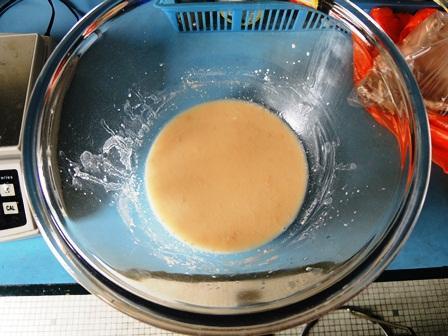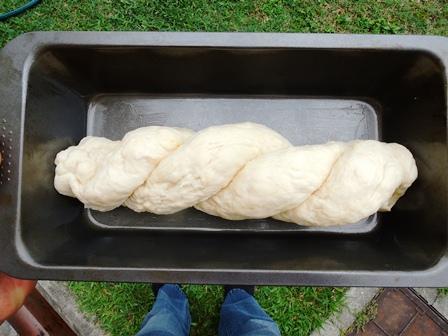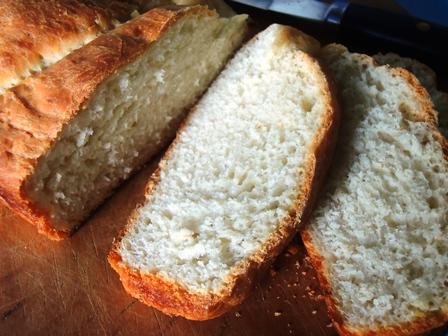Simple bread, plain and simple, a new method

I could make beautiful bread by kneading the dough for about 45 minutes and the breads, plain simple bread or wholemeal bread turned out beautiful and tasty. Each time I made bread I wondered “Why, Why Why Oh Dear God do I have to struggle so much for such a beautiful thing?”. From that day I used to ask myself ‘Why?’, ‘Why?’, ‘Why?’ and then one day it dawned on me that I was asking the wrong question.
You see, I didn’t want to struggle so much and I wanted an easier way to make simple bread. There were two problems I was facing. The first was why was it not possible to make simple bread from self-raising (or self-rising) flour and the other bigger problem was that why I had to do so much kneading to make tasty and beautiful bread.
Later on, I realised that I was asking the wrong question. I should not be asking “Why” but “How”. That changed my perspective. I had been experimenting making bread for about one and a half years and then one morning last month I woke up in bed and remembered helping my mother make pancakes when I was a kid. I had this vision of myself, transported back in time, as a young kid, leaning against the table top and stirring the pancake batter.
Those pancakes where good. My mom rarely made sweet pancakes. They were the savory kind with onions and chillies. I remembered stirring the pancake batter and I remembered the colour. Then the vision disappeared but I had the answer.
I believe I have discovered a new method of making bread. Traditionally there are four basic methods of making all types of bread including plain simple bread. They are
1. The Sponge and Dough Method,
2. The Straight Dough Method,
3. The No Time Dough Method and
4. The Modified No Time Dough method.
There is another method that is becoming popular and it is the
5. Batter Bread Method.
Do you know what the vision was showing me? The kneading process for bread was to get the gluten out. It is the gluten that makes the dough elastic and ‘bready’. My problem could be solved if I could ‘glutenise’ the bread quickly. The solution was in the early ‘glutinzation’ of the bread (Did I, just invent three new words for the English Language?) and that is how I invented the “Batter and Dough Method”.
It is an unbelievably simple and neat solution to get the gluten out before making the dough. The simplest way to get gluten out quickly was to make a batter. Hence, I have named the method “Batter and Dough” method. Below is the recipe for a plain simple bread.
The plain simple bread recipe
| Plain Simple Bread Recipe – New Method | ||||
| Item | Ingredients | Percentage | Weight | Weight |
| (%) | (g) | oz. | ||
| 1 | Bread Flour for Batter | 10 | 40.00 | 1.41 |
| 2 | Bread Flour for Dough | 90 | 360.00 | 12.67 |
| Subtotal | 100 | 400 | 14.08 | |
| Batter | ||||
| 3 | Cold water | 55 | 220.00 | 7.74 |
| 4 | Sugar | 2.5 | 10.00 | 0.35 |
| 5 | Instant Yeast | 1 | 4.00 | 0.14 |
| Dough | ||||
| 6 | Salt | 1 | 4.00 | 0.14 |
| 7 | Butter | 7 | 28.00 | 0.99 |
I have divided the simple bread making process into two stages, the first is making the Batter for the simple bread and the second is making the Dough for the simple bread. Hence 10% of the flour, or about 2 heaped desert spoons in this recipe, cold water, sugar and yeast are used to make the batter for the simple bread. Then after half an hour of soaking the small amount of flour in water, the rest of the flour, salt and butter is added in. This is a simple bread.
Photos of the plain simple bread new method process

Mix 10% of the bread flour, sugar and yeast in cold water to make the batter for the simple bread. Use a whisk to ensure that the flour is completely ‘dissolved’ in the water. I added the yeast and sugar at this stage to help the yeast begin multiplying earlier. You could have added them in the dough stage of the process as it did not make much difference to the final result.
When you mix flour with water, gluten will be released. To ensure sufficient gluten is released for the whole simple bread, let the flour soak in the water for half an hour. If you had added more flour or allowed the flour to soak longer than 30 minutes the plain simple bread will have a rough coarse mouth feel. This I think is because there will be more gluten to form longer molecular chains, resulting in a rough coarse bread. I have tried 40 minutes soak time, 15% and 30% of the bread flour soaked in water and all of them resulted in very rough coarse bread.

Grease your baking tin with butter and weigh out the rest of the ingredients while you are waiting for the batter to mature.

After half an hour, add in the rest of the bread flour – the 90% of the bread flour, and mix. I mixed it by hand just enough for all the flour to come in contact with the water – get moist. Then I added the salt and the butter. This is to ensure more gluten will be formed in the rest of the flour.

Then fold the dough on its self about 5 to 20 times. The dough will turn stiff and almost rubbery when cut.

Roll the dough out. Notice that I did not sprinkle the work surface with flour. Cut the roll into two equally long pieces and twist them over each other.

Place the twisted rolls into the greased baking tin to proof it. Notice that I had shaped the dough. This was just to show that you can manipulate the dough into various shapes. Leave the dough in the baking tin to proof for 4 hours.

After 4 hours the dough would have risen to fill up most of the baking tin. Bake for 25 to 40 minutes at 230C (446F). I ran many experiments with this plain simple bread recipe. Some baked for 25 minutes and others up to 40 minutes. If you bake for 25 minutes the plain simple bread will be just slightly damp inside and your plain simple bread will not dry up that fast upon slicing which means it will keep for a few days. If you baked for 35 minutes the plain simple bread would form a nice hard crust. I love bread with a hard crust.

The shaped plain simple bread. If you had baked for 35 minutes or longer the bread would be dark brown in colour.

Wonderful sliced plain simple bread. There was not much effort involved with this Batter and Dough Method and the bread was delicious.

It was so delicious that I began to eat it before I realised that I had not photographed the melting butter on the hot sliced bread.
Do check out how I succeeded in making bread from self raising flour / self rising flour.
Batter and Dough Method for making bread – no kneading
4. How to make garlic bread the batter and dough method
3. how to make bread the batter and dough method
2. How to make bread with self raising or self rising flour a new method
1. How to make plain simple bread a new method
This article on How to make plain simple bread a new method was researched and written by Peter Achutha
Leave a Reply